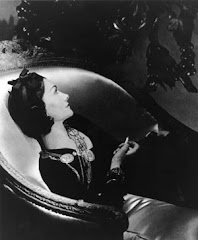The first purpose of clothes . . . was not warmth or decency, but ornament . . . Among wild people,* we find tattooing and painting even prior to clothes. The first spiritual want of a barbarous man is decoration; as indeed we still see among the barbarous classes in civilized countries. Thomas Carlyle 1795-1881
*We no longer speak of 'wild' or 'barbarous' people, yet the observation remains interesting, for it goes to the heart of the question, why do we decorate our bodies with clothes, cosmetics and jewellery? Despite the Puritans' assertions, clothing has never been merely a matter of warmth and protection. LG


5 comments:
Linda - have you ever read this book, "Fashion" as done by National Geographic? http://www.amazon.com/Fashion-Cathy-Newman/dp/0792233751/ref=pd_bbs_1?ie=UTF8&s=books&qid=1198245938&sr=1-1
It has fascinating discussions of why people dress and make up and tattoo themselves.
God I love you blog.
Toby, I just ordered that book on amazon.ca. It's out of print, so I snapped it up right away. I remember reading an article in National Geographic by Cathy Newman on Perfume that I loved, so I can't wait to see this book.
Amazing, I have read your blog for some time and I am amazed to see my ancestral people on your blog. Beautification is in the eye of the culture. This style of marking the skin is quite prevailent in New Zealand, still. In fact I have a number of them myself. I believe they embellish and illustrate milestones in my life, which has often been wild and savage :)
watergurl, in working on Québec and other Canadian Aboriginal arts, indeed one encounters a wide range of forms of adornment and decoration, even in the very earliest examples some ten thousand years old.
Yes, indeed this is a lovely blog - it is such a treat to read intelligent and well-crafted writing about "the clothes on people's backs".
Adornment and style are also important for some of the poorest people on Earth, whether South Asian ladies in villages and shantytowns in beautiful coloured saris or the mums in Haitian bidonvilles who turn their wee children out in spotless white dresses and shirts.
And it was an essential means of rediscovering human dignity for Western people as well, recovering from hell in Displaced Person camps. The late historian Ruth Gay's book "Safe Among the Germans" touches on these small ways of rebecoming human.
I do think there is a kernel of truth in what is sometimes described as "puritanism", though, as I think there can be a justified nausea about the oceans of "stuff" with which our contemporary Western societies are awash. But it is true that a lot of the nausea is a reaction to throwaway culture and cheap crap.
Post a Comment